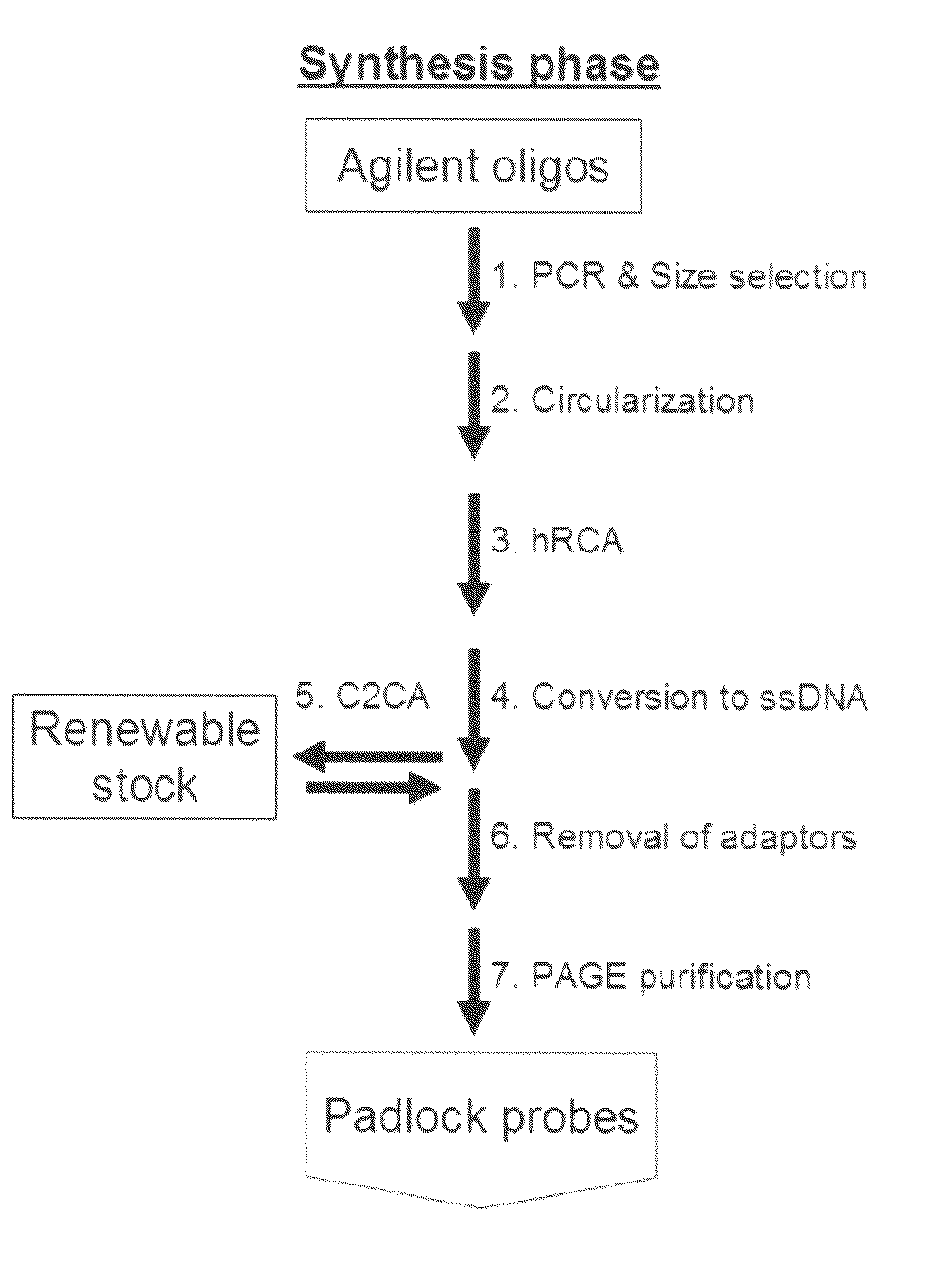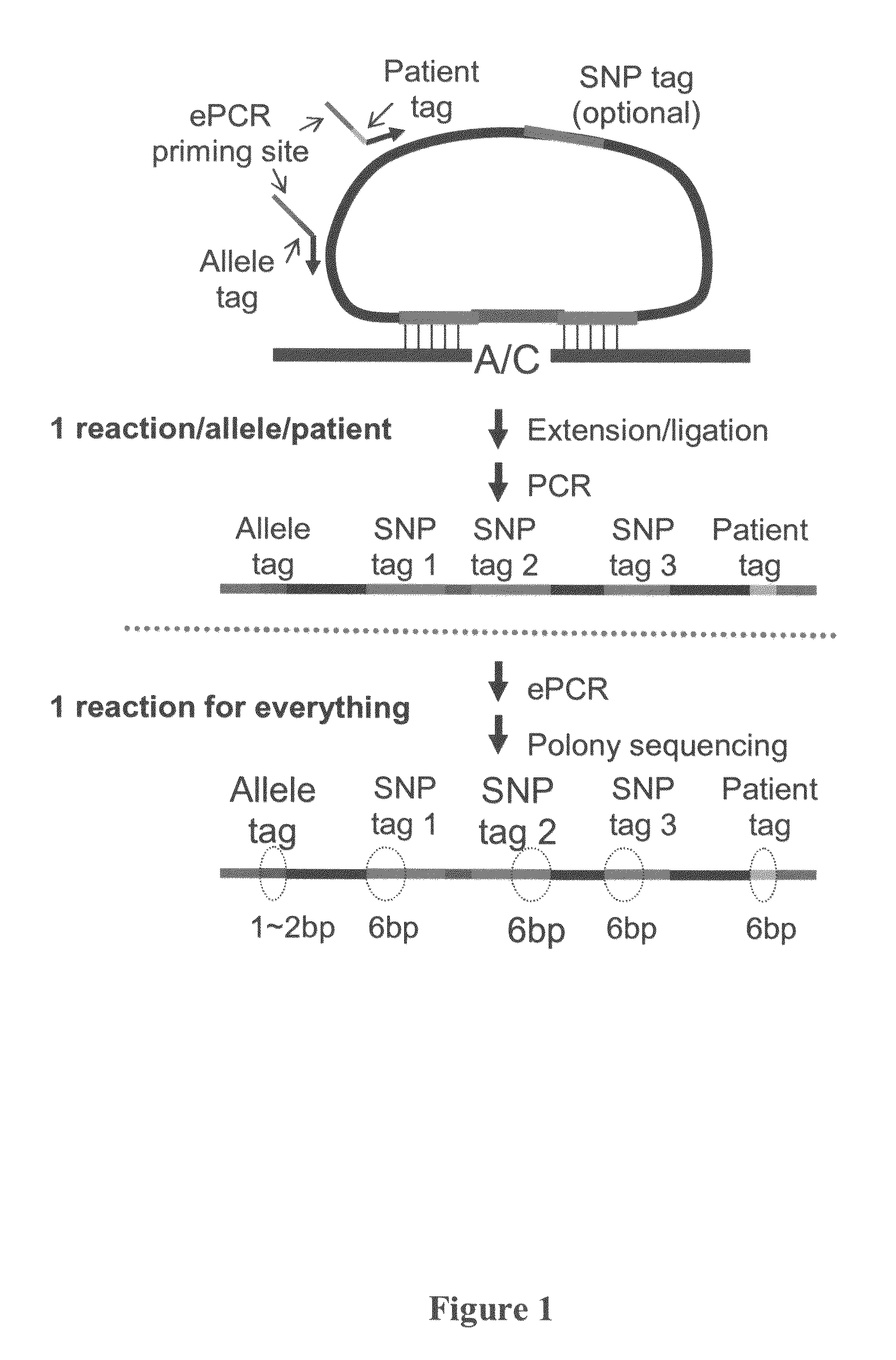Methods for making nucleotide probes for sequencing and synthesis
a nucleotide probe and sequencing technology, applied in the field of molecular inversion probe technology, can solve problems such as inability to facilitate amplification, and achieve the effect of increasing the number of loci and samples analyzed simultaneously and reducing the cos
- Summary
- Abstract
- Description
- Claims
- Application Information
AI Technical Summary
Benefits of technology
Problems solved by technology
Method used
Image
Examples
example i
Two-Dimensional Genotyping
[0101]A large number of padlock probes (oligonucleotide probes that can circularize) can be used to specifically capture single nucleotide polymorphisms (SNPs) from genomic DNA, and the associated SNP identities and genotypes can be subsequently assessed by massively parallel DNA sequencing (FIG. 3). Without intending to be bound by theory, padlock probes likely provide the highest specificity among current genotyping methods because the circularization involves the combination of (i) co-operative annealing of two short sequences to a target in a uni-molecular fashion, (ii) allelic-specific single-base extension, (iii) allelic-specific ligation. In contrast, both Affymetrix's GENECHIP® and Illumina's INFINIUM™ assay involve a hybridization step that has an inherent limitation in distinguishing very similar sequences. Without intending to be bound by theory, padlock probes likely represent the best opportunity to further increase the number of SNPs determine...
example ii
Circularization and Amplification of Long Oligonucleotides Synthesized on DNA Programmable Chips (Steps 1-5)
[0105]Performing genotyping of one million SNPs on one sample requires approximately 150 ng of padlock probes that contain one million species of a total length of 88 Mbp (assuming 400 ng of genomic template and a probe:target ratio of 6:1). With the most recent chip-synthesis technology at Agilent, one programmable chip can produce 22,000 or 44,000 long oligonucleotides at the scale of approximately 1 femtomole per oligonucleotide. In order to achieve the goal of ultra-low-cost SNP genotyping, a large quantity of padlock probes must be regenerated from oligonucleotides synthesized on a single set of Agilent chips at a low cost (less than $10 / 150 ng). Rolling circle amplification / hyperbranched rolling circle amplification (RCA / hRCA) on circularized oligonucleotides will be performed for this purpose.
[0106]RCA / hRCA has at least three major advantages over PCR-based methods. Fir...
example iii
Preparation of Padlock Probes from Amplified Oligonucleotides by Oligo-Guided Restriction Endonuclease Digestion (Step 6)
[0122]After amplification with RCA / hRCA, padlock probes are present as linear concatemers. Each padlock probe is flanked by adaptors at the 3′- and 5′-ends. RCA amplicons are single-stranded while hRCA amplicons can be converted into single-stranded forms using several methods mentioned above. Oligo-guided restriction endonuclease digestion (Szybalski (1985) Gene 40:169; Kim et al. (1988) Science 240:504; Zhu (1989) Anal Biochem. 177:120; Podhajska et al. (1992) Meth. Enzymol. 216:303) is used to release the “inserts” from linear concatemers (FIG. 4). Because each padlock probe has unique capturing single-stranded sequences at both 3′- and 5′-end, restriction endonuclease recognition sites must be located with the adaptor sequences. In addition, to break the concatemers precisely at the junctions between the adaptors and the inserts, the restriction endonuclease c...
PUM
| Property | Measurement | Unit |
|---|---|---|
| Tm | aaaaa | aaaaa |
| pH | aaaaa | aaaaa |
| temperature | aaaaa | aaaaa |
Abstract
Description
Claims
Application Information
 Login to View More
Login to View More - R&D
- Intellectual Property
- Life Sciences
- Materials
- Tech Scout
- Unparalleled Data Quality
- Higher Quality Content
- 60% Fewer Hallucinations
Browse by: Latest US Patents, China's latest patents, Technical Efficacy Thesaurus, Application Domain, Technology Topic, Popular Technical Reports.
© 2025 PatSnap. All rights reserved.Legal|Privacy policy|Modern Slavery Act Transparency Statement|Sitemap|About US| Contact US: help@patsnap.com



